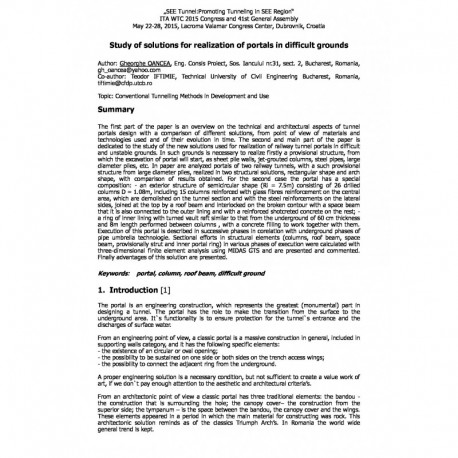Cart
0
0
No document
0,00 €
Total
Document successfully added to your shopping cart
Quantity
Total
There are 0 items in your cart.
There is 1 item in your cart.
Total documents
Total shipping
To be determined
Total
Search & filter
Search for a publication
Search & filter
Viewed documents

Study of solutions for realization of portals in difficult grounds
wtc2015_article_oanceagheorghe
The first part of the paper is an overview on the technical and architectural aspects of tunnel portals design with a comparison of different solutions, from point of view of materials and technologies used and of their evolution in time. The second and main part of the paper is dedicated to the study of the new solutions used for realization of railway tunnel portals in difficult and unstable grounds. In such grounds is necessary to realize firstly a provisional structure, from which the excavation of portal will start, as sheet pile walls, jet-grouted columns, steel pipes, large diameter piles, etc. In paper are analyzed portals of two railway tunnels, with a such provisional structure from large diameter piles, realized in two structural solutions, rectangular shape and arch shape, with comparison of results obtained. For the second case the portal has a special composition: - an exterior structure of semicircular shape (Ri = 7.5m) consisting of 26 drilled columns D = 1.08m, including 15 columns reinforced with glass fibres reinforcement on the central area, which are demolished on the tunnel section and with the steel reinforcements on the lateral sides, joined at the top by a roof beam and interlocked on the broken contour with a space beam that it is also connected to the outer lining and with a reinforced shotcreted concrete on the rest; - a ring of inner lining with turned vault raft similar to that from the underground of 60 cm thickness and 8m length performed between columns , with a concrete filling to work together with them. Execution of this portal is described in successive phases in corelation with underground phases of pipe umbrella technologie. Sectional efforts in structural elements (columns, roof beam, space beam, provisionally strut and inner portal ring) in various phases of execution were calculated with three-dimensional finite element analysis using MIDAS GTS and are presented and commented. Finally advantages of this solution are presented.


